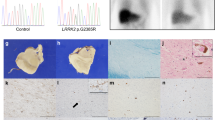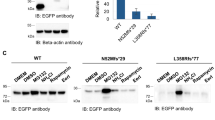Abstract
NR4A2, encoding a member of nuclear receptor superfamily1, is essential for the differentiation of the nigral dopaminergic neurons2,3,4. To determine whether NR4A2 is a susceptibility gene for Parkinson disease, we carried out genetic analyses in 201 individuals affected with Parkinson disease and 221 age-matched unaffected controls. We identified two mutations in NR4A2 associated with Parkinson disease (−291Tdel and −245T→G), which map to the first exon of NR4A2 and affect one allele in 10 of 107 individuals with familial Parkinson disease but not in any individuals with sporadic Parkinson disease (n = 94) or in unaffected controls (n = 221). The age at onset of disease and clinical features of these ten individuals were not different from those of individuals with typical Parkinson disease. The mutations resulted in a marked decrease in NR4A2 mRNA levels in transfected cell lines and in lymphocytes of affected individuals. Additionally, mutations in NR4A2 affect transcription of the gene encoding tyrosine hydroxylase. These data suggest that mutations in NR4A2 can cause dopaminergic dysfunction, associated with Parkinson disease.
This is a preview of subscription content, access via your institution
Access options
Subscribe to this journal
Receive 12 print issues and online access
$209.00 per year
only $17.42 per issue
Buy this article
- Purchase on Springer Link
- Instant access to full article PDF
Prices may be subject to local taxes which are calculated during checkout




Similar content being viewed by others
References
Law, S.W., Conneely, O.M., DeMayo, F.J. & O'Malley, B.W. Identification of a new brain-specific transcription factor, Nurr1. Mol. Endocrinol. 6, 2129–2135 (1992).
Zetterström, R.H. et al. Dopamine neuron agenesis in Nurr1-deficient mice. Science 276, 248–250 (1997).
Saucedo-Cardenas, O. et al. Nurr1 is essential for the induction of the dopaminergic phenotype and the survival of ventral mesencephalic late dopaminergic precursor neurons. Proc. Natl. Acad. Sci. USA 95, 4013–4018 (1998).
Castillo, S.O. et al. Dopamine biosynthesis is selectively abolished in substantia nigra-ventral tegmental area but not in hypothalamic neurons in mice with targeted disruption of the Nurr1 gene. Mol. Cell. Neurosci. 11, 36–46 (1998).
Langston, J.W. Epidemiology versus genetics in Parkinson's disease: progress in resolving an age-old debate. Ann. Neurol. 1 (Suppl), S45–S52 (1998).
Funayama, M. et al. A new locus for Parkinson's disease (PARK8) maps to chromosome 12p11.2–q13.1. Ann. Neurol. 51, 296–301 (2002).
Polymeropoulos, M.H. et al. Mutation in the α-synuclein gene identified in families with Parkinson's disease. Science 276, 2045–2047 (1997).
Kitada, T. et al. Mutations in the parkin gene cause autosomal recessive juvenile parkinsonism. Nature 392, 605–608 (1998).
Martin, E.D. et al. Association of single-nucleotide polymorphisms of the tau gene with late-onset Parkinson disease. JAMA 286, 2239–2324 (2001).
Hicks, A.A. et al. A susceptibility gene for late-onset idiopathic Parkinson's disease. Ann. Neurol. 52, 549–555 (2002).
Leroy, E. et al. The ubiquitin pathway in Parkinson's disease. Nature 396, 451–452 (1998).
Valente, E.M. et al. Localization of a novel locus for autosomal recessive early-onset parkinsonism, PARK6, on human chromosome 1p35–p36. Am. J. Hum. Genet. 68, 895–900 (2001).
Van Duijn, C.M. et al. PARK7, a novel locus for autosomal recessive early-onset parkinsonism, on chromosome 1p36. Am. J. Hum. Genet. 69, 629–634 (2001).
Gasser, T. et al. A susceptibility locus for Parkinson's disease maps to chromosome 2p13. Nat. Genet. 18, 262–265 (1998).
Farrer, M.J. et al. A chromosome 4p haplotype segregating with Parkinson's disease and postural tremor. Hum. Mol. Genet. 8, 81–85 (1999).
Saucedo-Cardenas, O. & Conneely, O.M. Comparative distribution of Nurr1 and Nur77 nuclear receptors in the mouse central nervous system. J. Mol. Neurosci. 7, 51–63 (1996).
Zetterstrom, R.H., Williams, R., Perlmann, T. & Olson, L. Cellular expression of the immediate early transcription factors Nurr1 and NGFI-B suggests a gene regulatory role in several brain regions including the nigro-striatal dopamine system. Mol. Brain. Res. 41, 111–120 (1996).
Le, W.D. et al. Selective agenesis of mesencephalic dopaminergic neurons in Nurr1 deficient mice. Exp. Neurol. 159, 451–458 (1999).
Le, W.D., Conneely, O.M., He, Y., Jankovic, J. & Appel, S.H. Reduced Nurr1 expression increases the vulnerability of mesencephalic dopamine neurons to MPTP-induced injure. J. Neurochem. 73, 2218–2221 (1999).
Mages, H.W., Rilke, O., Bravo, R., Senger, G. & Kroczek, R.A. NOT, a human immediate-early response gene closely related to the steroid/thyroid hormone receptor NAK1/TR3. Mol. Endocrinol. 8, 1583–1591 (1994).
Ichinose, H. et al. Molecular cloning of the human Nurr1 gene: characterization of the human gene and cDNA. Gene 230, 233–239 (1999).
Castillo, S.O., Xiao, Q., Lyu, M.S., Kozak, C.A. & Nikodem, V.M. Organization, sequence, chromosomal localization, and promoter identification of the mouse orphan nuclear receptor Nurr1 gene. Genomics 41, 250–257 (1997).
Torii, T., Kawarai, S., Nakamura, H. & Kawakami, H. Organization of the human orphan nuclear receptor Nurr1 gene. Gene 230, 225–232 (1999).
Iwawaki, T., Kohno, K. & Kobayashi, K. Identification of a potential Nurr1 response element that activates the tyrosine hydroxylase gene promoter in cultured cells. Biochem. Biophys. Res. Comm. 274, 590–595 (2000).
Sacchetti, P., Mitchell, T.R., Grameman, J.G. & Bannon, M.J. Nurr1 enhances transcription of the human dopamine transporter gene through a novel mechanism. J. Neurochem. 76, 1565–1572 (2001).
Buervenich, S. et al. NURR1 mutations in cases of schizophrenia and manic-depressive disorder. Am. J. Med. Gen. 96, 808–813 (2000).
Chen, Y.H., Tsai, M.T., Shaw, C-K. & Chen, C.H. Mutation analysis of the human NR4A2 gene, an essential gene for midbrain dopaminergic neurogenesis, in Schizophrenic patients. Am. J. Med. Gen. 108, 753–757 (2001).
Nataraj, A.J., Olivos-Glander, I., Kurusawa, N. & Highsmith, W.E. Jr. Single-strand conformation polymorphism and heteroduplex analysis for gel-based mutation detection. Electrophoresis 20, 1177–1185 (1999).
Healy, D.G., Sleiman, P., Sweeney, M.G., Eunson, L.H. & Wood, N.W. Exon 1 gene mutations are rare in familial PD. Mov. Disord. 17 (Suppl), S34 (2002).
Scott, W.K. et al. Complete genomic screen in Parkinson disease: evidence for multiple genes. JAMA 286, 2239–2244 (2001).
Acknowledgements
The authors thank C. Hunter, T. Ashizawa and W. Ondo for referring some of the individuals with Parkinson disease; W. Xie for technical assistance in NR4A2 mutation analysis; O.M. Conneely, T. Ashizawa and Y. Fu for critical review of the manuscript; and Y. Bassiakos for help with statistical analysis. This program was supported by a grant from the US National Institutes of Health, by a research grant from the American Federation for Aging Research to D.K.V. and by the National Parkinson Foundation, Center of Excellence, Baylor College of Medicine.
Author information
Authors and Affiliations
Corresponding author
Ethics declarations
Competing interests
The authors declare no competing financial interests.
Rights and permissions
About this article
Cite this article
Le, Wd., Xu, P., Jankovic, J. et al. Mutations in NR4A2 associated with familial Parkinson disease. Nat Genet 33, 85–89 (2003). https://doi.org/10.1038/ng1066
Received:
Accepted:
Published:
Issue Date:
DOI: https://doi.org/10.1038/ng1066
This article is cited by
-
The role of Nurr1-miR-30e-5p-NLRP3 axis in inflammation-mediated neurodegeneration: insights from mouse models and patients’ studies in Parkinson’s disease
Journal of Neuroinflammation (2023)
-
A sporadic Parkinson’s disease model via silencing of the ubiquitin–proteasome/E3 ligase component, SKP1A
Journal of Neural Transmission (2023)
-
The role of NURR1 in metabolic abnormalities of Parkinson’s disease
Molecular Neurodegeneration (2022)
-
A Nurr1 ligand C-DIM12 attenuates brain inflammation and improves functional recovery after intracerebral hemorrhage in mice
Scientific Reports (2022)
-
Maintenance of mitochondrial integrity in midbrain dopaminergic neurons governed by a conserved developmental transcription factor
Nature Communications (2022)



